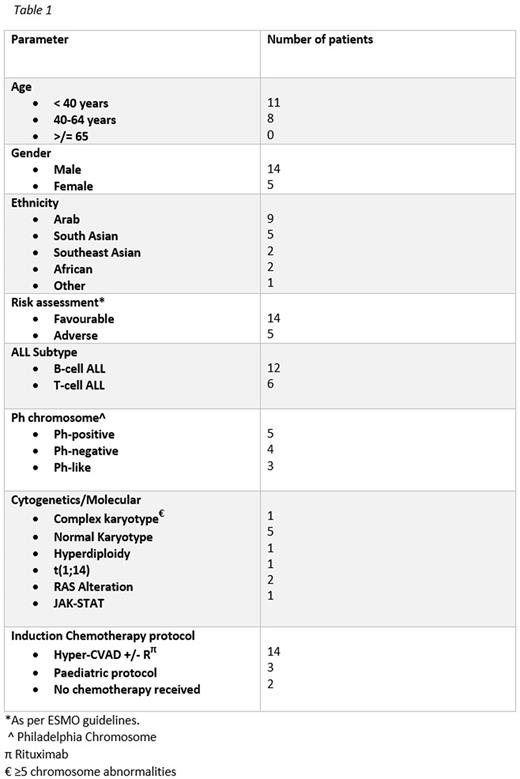Abstract
Population-based registries may provide data useful for clinical decisions in patients' populations not well presented by clinical studies, which is essential to establish recommendations for the management of patients in the real world.
The aim of the first Sheikh Shakhbout Medical City (SSMC) ongoing acute leukaemia registry is to obtain information about the demography, clinical presentation, genetic markers, risk stratification and disease response of patients with diverse ethnicities and backgrounds .The registry includes newly diagnosed adults with acute leukaemia, admitted to SSMC from June 2021 onward.
SSMC acute leukaemia registry is an observational retrospective and prospective study. Electrical medical records were used to collect data, and coding was used for each variable based on the 2017 European leukaemia network (ELN) and the 2016 European society for medical oncology (ESMO) clinical practice guidelines.
A total of 41 patients were registered between June 2021 and May 2022. Eighteen patients with Acute Lymphoblastic leukaemia/Lymphoma (ALL) and 1 patient mixed-lineage leukaemia (MLL). Of the 18 patients with ALL, 6 patients with T-cell ALL, one of them with antecedent Chronic myeloid leukaemia (CML), and 12 patients with B-cell ALL.
Seventy four percent of patients are males (n=14) and 26% (n=5) are females, 58% (n=11) are younger than 40 years of age, and 42% (n=8) are between 40 and 65 years old, with median age of 37 years at the time of diagnosis. Forty Seven percent of patients are Arabs, 26% are South Asian, 11% are Southeast Asian, 11% are African, and 5% are from other ethnicities (Table 1).
Seventy four percent (n=14) of patients have adverse prognosis as per Hoelzer D et al., (2016). Of the 12 patients with B-cell ALL, 5 patients with Philadelphia chromosome-positive, accounts for 41% of patients which is higher compared to the 31% reported percentage in other clinical trials (Gupta R et al., 2018), 3 patients with Philadelphia-like chromosome positive, accounts for 25% of patients which is within the reported percentage range in other trial canters (Hoelzer D et al., 2016; National Comprehensive Cancer Network [NCCN], 2022)
Induction regimens included paediatric protocols (n=3), hyperfractionated cyclophosphamide, vincristine, doxorubicin, and dexamethasone, alternating with high-dose methotrexate, and cytarabine (HyperCVAD) (n=14), and 2 patients did not receive induction chemotherapy due to refusal of therapy and loss of follow up.
As per the NCCN (2022), 6 patients achieved complete remission (CR) post induction,4 of which have negative minimal residual disease (MRD), 1 patient has positive MRD and 1 patients has failed MRD test. One patient achieved CR with incomplete hematologic recovery (CRi), 4 patients had partial remission, 2 patients were evaluated as treatment refractory, and 6 patients had no disease assessment post induction due to death or loss of follow up. Waca
SSMC is one of the major leukaemia centres in Abu Dhabi, United Arab Emirates (UAE), where petroleum and natural gas are the main industry. UAE population consists of mixed ethnicities with different socioeconomic backgrounds where consanguinity is common and air pollution exposure at home countries is a big possibility.
Despite the fact that our patient population is small, and statistically significant analysis might not be possible at this stage, we believe that our patient population demographics and genetic markers are not well-reflected in the standard guidelines. With longer observation and time the SSMC acute leukaemia registry promises to provide interesting data that may shed important input for better treatment algorithms.
Disclosures
No relevant conflicts of interest to declare.
Author notes
Asterisk with author names denotes non-ASH members.


